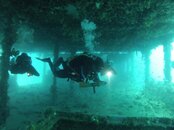00wabbit
Contributor
Just to respond to Op's title question.
I don't think the BP/w is confusing at all in itself but when I was starting last year, the shop I went to only had a couple and I didn't really know what they were. I heard them mentioned a couple of times on scubaboard but didnt really research too much at the time. As a fresh new diver with no experience I was looking at the Scubabpro Nighthawk with air2. It made sens to me, super cool design. It had a big embroidered hawk on the inside. Air2 meant one less hose to carry around and the 45 pound wing on the XXL version was sure to float my fat ass.
On the other hand the shop had some steel backplates hanging up on a rack and then on a different rack there were some floppy plain black wings. To my consumer eyes they just seemed so old fashioned and cheap. It was also a little weird to see how everything would work together. I mean the knighthawk had integrated weight pockets. Where was I supposed to put my weights on a bp/w? I didn't like the weightbelts. The knighthawk had pockets (small ones) but at least I could put my little flashlight in them, where did they go on the bp/w? The knighthawk had that air2, if I got the BP/w I would have to deal with another hose. The Knighthawk had padding and d-rings and clips. How were they supposed to get me out of the bp/w? That stiff webbing looks so uncomfortable. I don't want a hard metal plate on my back that is surely uncomfortable too.
Besides the knighthawk says scubapro on it and all my instructors have scubapro. If its good enough for the pros it's good enough for me.
That was some of my thought process. So I bought the knighthawk.
Then I went to a drysuit. Now my problem was, that I had so much lead in the knighthawk pockets that I was overloading them. Without a crotchstrap it liked to ride a bit high on me and when it did it started to push me head down. I countered this unsuccessfully with heavier fins and ankle weights. Then I dove colder with more undergarments and had more trouble with weights. I eventually ditched the ankle weights, but still felt like a trainwreck underwater.
Then after diving with more folks with drysuits, I switched to steel tanks, bp/w, long hose, dui weight harness. I've almost cut the lead I carry in half by adding the steel plate, removing all that padding, and reducing weight after my safety stops if my tank is near empty and I still sink.
Now I get it, it makes much more sense, but as a consumer of flashy new cars with flashy new features and phones that can do everything in one it is hard to understand the BP/w at first unless someone shows you.
I don't think the BP/w is confusing at all in itself but when I was starting last year, the shop I went to only had a couple and I didn't really know what they were. I heard them mentioned a couple of times on scubaboard but didnt really research too much at the time. As a fresh new diver with no experience I was looking at the Scubabpro Nighthawk with air2. It made sens to me, super cool design. It had a big embroidered hawk on the inside. Air2 meant one less hose to carry around and the 45 pound wing on the XXL version was sure to float my fat ass.
On the other hand the shop had some steel backplates hanging up on a rack and then on a different rack there were some floppy plain black wings. To my consumer eyes they just seemed so old fashioned and cheap. It was also a little weird to see how everything would work together. I mean the knighthawk had integrated weight pockets. Where was I supposed to put my weights on a bp/w? I didn't like the weightbelts. The knighthawk had pockets (small ones) but at least I could put my little flashlight in them, where did they go on the bp/w? The knighthawk had that air2, if I got the BP/w I would have to deal with another hose. The Knighthawk had padding and d-rings and clips. How were they supposed to get me out of the bp/w? That stiff webbing looks so uncomfortable. I don't want a hard metal plate on my back that is surely uncomfortable too.
Besides the knighthawk says scubapro on it and all my instructors have scubapro. If its good enough for the pros it's good enough for me.
That was some of my thought process. So I bought the knighthawk.
Then I went to a drysuit. Now my problem was, that I had so much lead in the knighthawk pockets that I was overloading them. Without a crotchstrap it liked to ride a bit high on me and when it did it started to push me head down. I countered this unsuccessfully with heavier fins and ankle weights. Then I dove colder with more undergarments and had more trouble with weights. I eventually ditched the ankle weights, but still felt like a trainwreck underwater.
Then after diving with more folks with drysuits, I switched to steel tanks, bp/w, long hose, dui weight harness. I've almost cut the lead I carry in half by adding the steel plate, removing all that padding, and reducing weight after my safety stops if my tank is near empty and I still sink.
Now I get it, it makes much more sense, but as a consumer of flashy new cars with flashy new features and phones that can do everything in one it is hard to understand the BP/w at first unless someone shows you.





